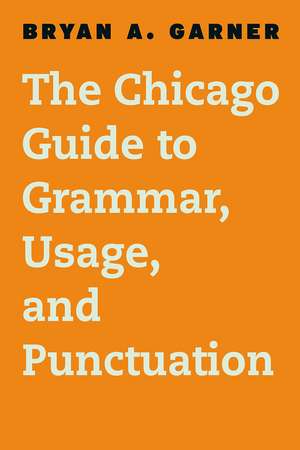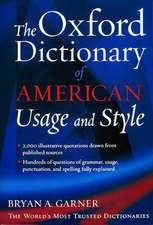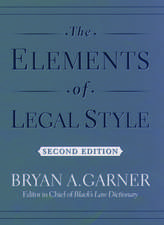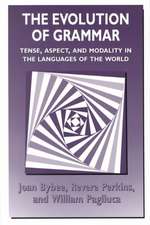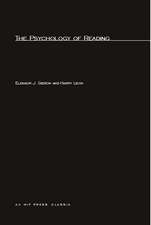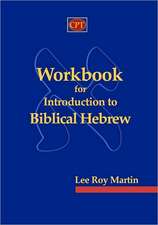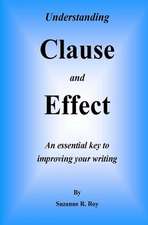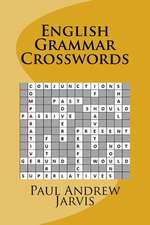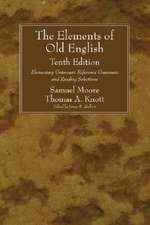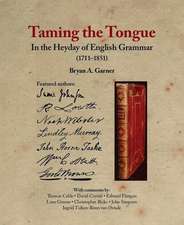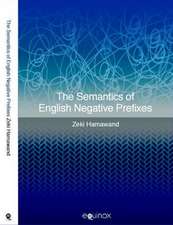The Chicago Guide to Grammar, Usage, and Punctuation: Chicago Guides to Writing, Editing, and Publishing
Autor Bryan A. Garneren Limba Engleză Hardback – 16 mai 2016
Few people can write on the English language with the authority of Bryan A. Garner. The author of The Chicago Manual of Style’s popular “Grammar and Usage” chapter, Garner explains the vagaries of English with absolute precision and utmost clarity. With The Chicago Guide to Grammar, Usage, and Punctuation, he has written the definitive guide for writers who want their prose to be both memorable and correct.
Throughout the book Garner describes standard literary English—the forms that mark writers and speakers as educated users of the language. He also offers historical context for understanding the development of these forms. The section on grammar explains how the canonical parts of speech came to be identified, while the section on syntax covers the nuances of sentence patterns as well as both traditional sentence diagramming and transformational grammar. The usage section provides an unprecedented trove of empirical evidence in the form of Google Ngrams, diagrams that illustrate the changing prevalence of specific terms over decades and even centuries of English literature. Garner also treats punctuation and word formation, and concludes the book with an exhaustive glossary of grammatical terms and a bibliography of suggested further reading and references.
The Chicago Guide to Grammar, Usage, and Punctuation is a magisterial work, the culmination of Garner’s lifelong study of the English language. The result is a landmark resource that will offer clear guidelines to students, writers, and editors alike.
Throughout the book Garner describes standard literary English—the forms that mark writers and speakers as educated users of the language. He also offers historical context for understanding the development of these forms. The section on grammar explains how the canonical parts of speech came to be identified, while the section on syntax covers the nuances of sentence patterns as well as both traditional sentence diagramming and transformational grammar. The usage section provides an unprecedented trove of empirical evidence in the form of Google Ngrams, diagrams that illustrate the changing prevalence of specific terms over decades and even centuries of English literature. Garner also treats punctuation and word formation, and concludes the book with an exhaustive glossary of grammatical terms and a bibliography of suggested further reading and references.
The Chicago Guide to Grammar, Usage, and Punctuation is a magisterial work, the culmination of Garner’s lifelong study of the English language. The result is a landmark resource that will offer clear guidelines to students, writers, and editors alike.
Din seria Chicago Guides to Writing, Editing, and Publishing
-
 Preț: 97.02 lei
Preț: 97.02 lei -
 Preț: 186.13 lei
Preț: 186.13 lei -
 Preț: 138.20 lei
Preț: 138.20 lei -
 Preț: 119.96 lei
Preț: 119.96 lei -
 Preț: 103.49 lei
Preț: 103.49 lei -
 Preț: 107.47 lei
Preț: 107.47 lei -
 Preț: 115.67 lei
Preț: 115.67 lei -
 Preț: 131.51 lei
Preț: 131.51 lei -
 Preț: 133.22 lei
Preț: 133.22 lei -
 Preț: 147.49 lei
Preț: 147.49 lei -
 Preț: 107.91 lei
Preț: 107.91 lei -
 Preț: 141.39 lei
Preț: 141.39 lei -
 Preț: 114.48 lei
Preț: 114.48 lei -
 Preț: 208.45 lei
Preț: 208.45 lei -
 Preț: 148.03 lei
Preț: 148.03 lei -
 Preț: 154.55 lei
Preț: 154.55 lei -
 Preț: 132.33 lei
Preț: 132.33 lei -
 Preț: 116.15 lei
Preț: 116.15 lei -
 Preț: 194.53 lei
Preț: 194.53 lei -
 Preț: 157.04 lei
Preț: 157.04 lei -
 Preț: 138.80 lei
Preț: 138.80 lei -
 Preț: 99.83 lei
Preț: 99.83 lei -
 Preț: 91.27 lei
Preț: 91.27 lei -
 Preț: 147.26 lei
Preț: 147.26 lei -
 Preț: 107.66 lei
Preț: 107.66 lei -
 Preț: 139.72 lei
Preț: 139.72 lei -
 Preț: 98.88 lei
Preț: 98.88 lei -
 Preț: 124.16 lei
Preț: 124.16 lei -
 Preț: 122.50 lei
Preț: 122.50 lei -
 Preț: 192.95 lei
Preț: 192.95 lei -
 Preț: 81.69 lei
Preț: 81.69 lei -
 Preț: 122.59 lei
Preț: 122.59 lei -
 Preț: 100.37 lei
Preț: 100.37 lei -
 Preț: 104.53 lei
Preț: 104.53 lei -
 Preț: 185.26 lei
Preț: 185.26 lei -
 Preț: 149.63 lei
Preț: 149.63 lei -
 Preț: 147.29 lei
Preț: 147.29 lei -
 Preț: 115.71 lei
Preț: 115.71 lei -
 Preț: 407.90 lei
Preț: 407.90 lei -
 Preț: 186.40 lei
Preț: 186.40 lei -
 Preț: 232.90 lei
Preț: 232.90 lei -
 Preț: 236.05 lei
Preț: 236.05 lei -
 Preț: 143.87 lei
Preț: 143.87 lei
Preț: 304.62 lei
Nou
Puncte Express: 457
Preț estimativ în valută:
58.34€ • 59.53$ • 49.08£
58.34€ • 59.53$ • 49.08£
Carte disponibilă
Livrare economică 04-18 februarie
Preluare comenzi: 021 569.72.76
Specificații
ISBN-13: 9780226188850
ISBN-10: 022618885X
Pagini: 552
Ilustrații: 115 line drawings
Dimensiuni: 178 x 254 x 43 mm
Greutate: 1.11 kg
Ediția:1
Editura: University of Chicago Press
Colecția University of Chicago Press
Seria Chicago Guides to Writing, Editing, and Publishing
ISBN-10: 022618885X
Pagini: 552
Ilustrații: 115 line drawings
Dimensiuni: 178 x 254 x 43 mm
Greutate: 1.11 kg
Ediția:1
Editura: University of Chicago Press
Colecția University of Chicago Press
Seria Chicago Guides to Writing, Editing, and Publishing
Notă biografică
Bryan A. Garner is president of LawProse, Inc. and Distinguished Research Professor of Law at Southern Methodist University. He is the author of the "Grammar and Usage" chapter of The Chicago Manual of Style and editor in chief of Black’s Law Dictionary. His many books on language and law include Garner’s Modern English Usage and Legal Writing in Plain English, the latter from the University of Chicago Press.
Cuprins
Introduction
Sentences, Clauses, and Their Patterns
Introduction
Sources for Inset Quotations
Select Bibliography
Acknowledgments
Word Index
General Index
Pronunciation Guide
1 The field of grammar
2 Who killed grammar?
3 Why study grammar?
4 Overview of the book
I. The Traditional Parts of Speech2 Who killed grammar?
3 Why study grammar?
4 Overview of the book
5 How did we arrive at the canonical eight?
Nouns Traditional Classifications
6 Nouns generally
7 Common nouns
8 Proper nouns
9 Count nouns
10 Collective nouns
11 Expressions of multitude
12 Expressions of partition
13 Mass nouns
Properties of Nouns
14 Generally
15 Case
16 Number
17 Gender
18 Person
Plurals
19 Generally
20 Adding “‑s” or “‑es”
21 Plurals of proper nouns
22 Nouns ending in “‑f” or “‑fe”
23 Nouns ending in “‑o”
24 Nouns ending in “‑y”
25 Nouns ending in “‑ics”
26 Compound nouns
27 Irregular plurals
28 Borrowed plurals
29 Plural form with singular sense
30 Plural-form proper nouns
31 Tricky anomalies
Case
32 Function
33 Common case, nominative function
34 Common case, objective function
35 Genitive case
36 The “of”-genitive
37 Genitives of titles and names
38 Joint and separate genitives
Agent and Recipient Nouns
39 Definitions; use
40 Appositives: definition and use
Conversions
41 Nouns as adjectives
42 Nouns as verbs
43 Adverbial functions
44 Other conversions
Pronouns6 Nouns generally
7 Common nouns
8 Proper nouns
9 Count nouns
10 Collective nouns
11 Expressions of multitude
12 Expressions of partition
13 Mass nouns
Properties of Nouns
14 Generally
15 Case
16 Number
17 Gender
18 Person
Plurals
19 Generally
20 Adding “‑s” or “‑es”
21 Plurals of proper nouns
22 Nouns ending in “‑f” or “‑fe”
23 Nouns ending in “‑o”
24 Nouns ending in “‑y”
25 Nouns ending in “‑ics”
26 Compound nouns
27 Irregular plurals
28 Borrowed plurals
29 Plural form with singular sense
30 Plural-form proper nouns
31 Tricky anomalies
Case
32 Function
33 Common case, nominative function
34 Common case, objective function
35 Genitive case
36 The “of”-genitive
37 Genitives of titles and names
38 Joint and separate genitives
Agent and Recipient Nouns
39 Definitions; use
40 Appositives: definition and use
Conversions
41 Nouns as adjectives
42 Nouns as verbs
43 Adverbial functions
44 Other conversions
Definition and Uses
45 “Pronoun” defined
46 Antecedents of pronouns
47 Clarity of antecedent
48 Pronouns without antecedents
49 Sentence meaning
Properties of Pronouns
50 Four properties
51 Number and antecedent
52 Exceptions regarding number of the antecedent
53 Pronoun with multiple antecedents
54 Some traditional singular pronouns
55 Gender
56 Case
57 Pronouns in apposition
58 Nominative case misused for objective
Classes of Pronouns
59 Seven classes
Personal Pronouns
60 Form
61 Identification
62 Changes in form
63 Agreement generally
64 Expressing gender
65 Determining gender
66 Special rules
67 Case after linking verb
68 Case after “than” or “as–as”
69 Special uses
70 The singular “they”
Possessive Pronouns
71 Uses and forms
72 Possessive pronouns vs contractions
Reflexive and Intensive Pronouns
73 Compound personal pronouns: “‑self” forms
74 Basic uses of reflexive and intensive pronouns
Demonstrative Pronouns
75 Definition
Reciprocal Pronouns
76 Generally
77 Simple and phrasal pronouns
Interrogative Pronouns
78 Definition
79 Referent of interrogative pronouns
Relative Pronouns
80 Definition
81 Gender, number, and case with relative pronouns
82 Positional nuances
83 Antecedent
84 Remote relative clauses
85 Omitted antecedent
86 Relative pronoun and the antecedent “one”
87 Function of relative pronoun in clause
88 Genitive forms
89 “Whose” and “of which”
90 Compound relative pronouns
91 “Who” vs“whom”
Indefinite Pronouns
92 Generally
93 The indefinite pronoun “one”
Adjectives45 “Pronoun” defined
46 Antecedents of pronouns
47 Clarity of antecedent
48 Pronouns without antecedents
49 Sentence meaning
Properties of Pronouns
50 Four properties
51 Number and antecedent
52 Exceptions regarding number of the antecedent
53 Pronoun with multiple antecedents
54 Some traditional singular pronouns
55 Gender
56 Case
57 Pronouns in apposition
58 Nominative case misused for objective
Classes of Pronouns
59 Seven classes
Personal Pronouns
60 Form
61 Identification
62 Changes in form
63 Agreement generally
64 Expressing gender
65 Determining gender
66 Special rules
67 Case after linking verb
68 Case after “than” or “as–as”
69 Special uses
70 The singular “they”
Possessive Pronouns
71 Uses and forms
72 Possessive pronouns vs contractions
Reflexive and Intensive Pronouns
73 Compound personal pronouns: “‑self” forms
74 Basic uses of reflexive and intensive pronouns
Demonstrative Pronouns
75 Definition
Reciprocal Pronouns
76 Generally
77 Simple and phrasal pronouns
Interrogative Pronouns
78 Definition
79 Referent of interrogative pronouns
Relative Pronouns
80 Definition
81 Gender, number, and case with relative pronouns
82 Positional nuances
83 Antecedent
84 Remote relative clauses
85 Omitted antecedent
86 Relative pronoun and the antecedent “one”
87 Function of relative pronoun in clause
88 Genitive forms
89 “Whose” and “of which”
90 Compound relative pronouns
91 “Who” vs“whom”
Indefinite Pronouns
92 Generally
93 The indefinite pronoun “one”
Types of Adjectives
94 Definition
95 Qualitative adjectives
96 Quantitative adjectives
97 Demonstrative adjectives
98 Possessive adjectives
99 Interrogative adjectives
100 Distributive adjectives
101 Indefinite adjectives
102 Pronominal adjectives
103 Proper adjectives
104 Compound adjectives
105 Relative adjectives
Articles as Limiting Adjectives
106 Definition
107 Definite article
108 Definite articles and proper names
109 Indefinite article
110 Indefinite article in specific reference
111 Choosing “a” or “an”
112 Articles with coordinate nouns
113 Effect on meaning
114 Omitted article and zero article
115 Article as pronoun substitute
Dates as Adjectives
116 Use and punctuation
Position of Adjectives
117 Basic rules
118 After possessives
119 Adjective modifying pronoun
120 Predicate adjective
121 Dangling participles
122 Distinguishing an adjective from an adverb or participle
Degrees of Adjectives
123 Generally
124 Comparative forms
125 Superlative forms
126 Forming comparatives and superlatives
127 Equal and unequal comparisons
128 Noncomparable adjectives
Special Types of Adjectives
129 Participial adjectives
130 Coordinate adjectives
131 Phrasal adjectives
132 Exceptions for hyphenating phrasal adjectives
Functional Variation
133 Adjectives as nouns
134 Adjectives as verbs
135 Other parts of speech functioning as adjectives
136 The weakening effect of injudicious adjectives
Verbs94 Definition
95 Qualitative adjectives
96 Quantitative adjectives
97 Demonstrative adjectives
98 Possessive adjectives
99 Interrogative adjectives
100 Distributive adjectives
101 Indefinite adjectives
102 Pronominal adjectives
103 Proper adjectives
104 Compound adjectives
105 Relative adjectives
Articles as Limiting Adjectives
106 Definition
107 Definite article
108 Definite articles and proper names
109 Indefinite article
110 Indefinite article in specific reference
111 Choosing “a” or “an”
112 Articles with coordinate nouns
113 Effect on meaning
114 Omitted article and zero article
115 Article as pronoun substitute
Dates as Adjectives
116 Use and punctuation
Position of Adjectives
117 Basic rules
118 After possessives
119 Adjective modifying pronoun
120 Predicate adjective
121 Dangling participles
122 Distinguishing an adjective from an adverb or participle
Degrees of Adjectives
123 Generally
124 Comparative forms
125 Superlative forms
126 Forming comparatives and superlatives
127 Equal and unequal comparisons
128 Noncomparable adjectives
Special Types of Adjectives
129 Participial adjectives
130 Coordinate adjectives
131 Phrasal adjectives
132 Exceptions for hyphenating phrasal adjectives
Functional Variation
133 Adjectives as nouns
134 Adjectives as verbs
135 Other parts of speech functioning as adjectives
136 The weakening effect of injudicious adjectives
Definitions
137 Verbs generally
138 Transitive and intransitive verbs
139 Ergative verbs
140 Dynamic and stative verbs
141 Regular and irregular verbs
142 Linking verbs
143 Phrasal verbs
144 Principal and auxiliary verbs
145 Verb phrases
146 Contractions
Infinitives
147 Definition
148 Split infinitive
149 Uses of infinitive
150 Dangling infinitive
Participles and Gerunds
151 Participles generally
152 Forming present participles
153 Forming past participles
154 Participial phrases
155 Gerunds
156 Gerund phrases
157 Distinguishing between participles and gerunds
158 Fused participles
159 Dangling participles
160 Dangling gerunds
Properties of Verbs
161 Five properties
VOICE
162 Active and passive voice
163 Progressive conjugation and voice
MOOD
164 Generally
165 Indicative mood
166 Imperative mood
167 Subjunctive mood
168 Subjunctive vsindicative mood
169 Present subjunctive
170 Past subjunctive
171 Past-perfect subjunctive
TENSE
172 Generally
173 Present tense
174 Past indicative
175 Future tense
176 Present-perfect tense
177 Past-perfect tense
178 Future-perfect tense
179 Progressive tenses
180 Backshifting in reported speech
TENSES ILLUSTRATED
181 Conjugation of the regular verb “to call”
182 Conjugation of the irregular verb “to hide”
183 Conjugation of the verb “to be”
PERSON
184 Generally
NUMBER
185 Generally
186 Agreement in person and number
187 Disjunctive compound subjects
188 Conjunctive compound subjects
189 Some other nuances of number involving conjunctions
190 Peculiar nouns that are plural in form but singular in sense
191 Agreement of indefinite pronouns
192 Relative pronouns as subjects
193 “There is”; “Here is”
194 False attraction to intervening matter
195 False attraction to predicate noun
196 Misleading connectives: “as well as,” “along with,” “together with,” etc
197 Agreement in first and second person
Auxiliary Verbs
198 Generally
199 Modal auxiliaries
200 “Can” and “could”
201 “May” and “might”
202 “Must”
203 “Ought”
204 “Shall”
205 “Should”
206 “Will” and “would”
207 “Dare” and “need”
208 “Do”
209 “Have”
Adverbs137 Verbs generally
138 Transitive and intransitive verbs
139 Ergative verbs
140 Dynamic and stative verbs
141 Regular and irregular verbs
142 Linking verbs
143 Phrasal verbs
144 Principal and auxiliary verbs
145 Verb phrases
146 Contractions
Infinitives
147 Definition
148 Split infinitive
149 Uses of infinitive
150 Dangling infinitive
Participles and Gerunds
151 Participles generally
152 Forming present participles
153 Forming past participles
154 Participial phrases
155 Gerunds
156 Gerund phrases
157 Distinguishing between participles and gerunds
158 Fused participles
159 Dangling participles
160 Dangling gerunds
Properties of Verbs
161 Five properties
VOICE
162 Active and passive voice
163 Progressive conjugation and voice
MOOD
164 Generally
165 Indicative mood
166 Imperative mood
167 Subjunctive mood
168 Subjunctive vsindicative mood
169 Present subjunctive
170 Past subjunctive
171 Past-perfect subjunctive
TENSE
172 Generally
173 Present tense
174 Past indicative
175 Future tense
176 Present-perfect tense
177 Past-perfect tense
178 Future-perfect tense
179 Progressive tenses
180 Backshifting in reported speech
TENSES ILLUSTRATED
181 Conjugation of the regular verb “to call”
182 Conjugation of the irregular verb “to hide”
183 Conjugation of the verb “to be”
PERSON
184 Generally
NUMBER
185 Generally
186 Agreement in person and number
187 Disjunctive compound subjects
188 Conjunctive compound subjects
189 Some other nuances of number involving conjunctions
190 Peculiar nouns that are plural in form but singular in sense
191 Agreement of indefinite pronouns
192 Relative pronouns as subjects
193 “There is”; “Here is”
194 False attraction to intervening matter
195 False attraction to predicate noun
196 Misleading connectives: “as well as,” “along with,” “together with,” etc
197 Agreement in first and second person
Auxiliary Verbs
198 Generally
199 Modal auxiliaries
200 “Can” and “could”
201 “May” and “might”
202 “Must”
203 “Ought”
204 “Shall”
205 “Should”
206 “Will” and “would”
207 “Dare” and “need”
208 “Do”
209 “Have”
Definition and Formation
210 Generally
211 Sentence adverbs
212 Adverbial suffixes
213 Adverbs without suffixes
214 Distinguished from adjectives
Simple vs Compound Adverbs
215 Standard and flat adverbs
216 Phrasal and compound adverbs
Types of Adverbs
217 Adverbs of manner
218 Adverbs of time
219 Adverbs of place
220 Adverbs of degree
221 Adverbs of reason
222 Adverbs of consequence
223 Adverbs of number
224 Interrogative adverbs
225 Exclamatory adverbs
226 Affirmative and negative adverbs
227 Relative adverbs
228 Conjunctive adverbs
Adverbial Degrees
229 Generally
230 Comparative forms
231 Superlative forms
232 Irregular adverbs
233 Noncomparable adverbs
Position of Adverbs
234 Placement as affecting meaning
235 Modifying words other than verbs
236 Modifying intransitive verbs
237 Adverbs and linking verbs
238 Adverb within verb phrase
239 Importance of placement
240 Adverbial objective
241 Adverbial clause
242 “Only”
Prepositions210 Generally
211 Sentence adverbs
212 Adverbial suffixes
213 Adverbs without suffixes
214 Distinguished from adjectives
Simple vs Compound Adverbs
215 Standard and flat adverbs
216 Phrasal and compound adverbs
Types of Adverbs
217 Adverbs of manner
218 Adverbs of time
219 Adverbs of place
220 Adverbs of degree
221 Adverbs of reason
222 Adverbs of consequence
223 Adverbs of number
224 Interrogative adverbs
225 Exclamatory adverbs
226 Affirmative and negative adverbs
227 Relative adverbs
228 Conjunctive adverbs
Adverbial Degrees
229 Generally
230 Comparative forms
231 Superlative forms
232 Irregular adverbs
233 Noncomparable adverbs
Position of Adverbs
234 Placement as affecting meaning
235 Modifying words other than verbs
236 Modifying intransitive verbs
237 Adverbs and linking verbs
238 Adverb within verb phrase
239 Importance of placement
240 Adverbial objective
241 Adverbial clause
242 “Only”
Definition and Types
243 Generally
244 Simple, compound
245 Phrasal prepositions
246 Participial prepositions
Prepositional Phrases
247 Generally
248 Prepositional function
249 Placement
250 Refinements on placement
251 Preposition-stranding
252 Clashing prepositions
253 Elliptical phrases
254 Case of pronouns
Other Prepositional Issues
255 Functional variation
256 Use and misuse of “like”
Limiting Prepositional Phrases
257 Avoiding overuse
258 Cutting prepositional phrases
259 Cutting unnecessary prepositions
260 Replacing with adverbs
261 Replacing with genitives
262 Using active voice
Conjunctions243 Generally
244 Simple, compound
245 Phrasal prepositions
246 Participial prepositions
Prepositional Phrases
247 Generally
248 Prepositional function
249 Placement
250 Refinements on placement
251 Preposition-stranding
252 Clashing prepositions
253 Elliptical phrases
254 Case of pronouns
Other Prepositional Issues
255 Functional variation
256 Use and misuse of “like”
Limiting Prepositional Phrases
257 Avoiding overuse
258 Cutting prepositional phrases
259 Cutting unnecessary prepositions
260 Replacing with adverbs
261 Replacing with genitives
262 Using active voice
263 Definition and types
264 Types of conjunctions: simple and compound
265 Coordinating conjunctions
266 Correlative conjunctions
267 Copulative conjunctions
268 Adversative conjunctions
269 Disjunctive conjunctions
270 Final conjunctions
271 Subordinating conjunctions
272 Special uses of subordinating conjunctions
273 Adverbial conjunctions
274 Expletive conjunctions
275 Disguised conjunctions
276 “With” used loosely as a conjunction
277 Beginning a sentence with a conjunction
278 Beginning a sentence with “however”
279 Conjunctions and the number of a verb
Interjections264 Types of conjunctions: simple and compound
265 Coordinating conjunctions
266 Correlative conjunctions
267 Copulative conjunctions
268 Adversative conjunctions
269 Disjunctive conjunctions
270 Final conjunctions
271 Subordinating conjunctions
272 Special uses of subordinating conjunctions
273 Adverbial conjunctions
274 Expletive conjunctions
275 Disguised conjunctions
276 “With” used loosely as a conjunction
277 Beginning a sentence with a conjunction
278 Beginning a sentence with “however”
279 Conjunctions and the number of a verb
280 Definition
281 Usage generally
282 Functional variation
283 Words that are exclusively interjections
284 Punctuating interjections
285 “O” and “oh”
II Syntax281 Usage generally
282 Functional variation
283 Words that are exclusively interjections
284 Punctuating interjections
285 “O” and “oh”
Sentences, Clauses, and Their Patterns
286 Definition
287 Statements
288 Questions
289 Some exceptional types of questions
290 Directives
291 Exceptional directives
292 Exclamations
The Four Traditional Types of Sentence Structures
293 Simple sentence
294 Compound sentence
295 Complex sentence
296 Compound-complex sentence
English Sentence Patterns
297 Importance of word order
298 The basic SVO pattern
299 All seven patterns
300 Variations on ordering the elements
301 Constituent elements
302 Identifying the subject
303 Identifying the predicate
304 Identifying the verb
305 Identifying the object
306 Identifying complements
307 Inner and outer complements
308 Identifying the adverbial element
Clauses
309 In general
310 Relative clauses
311 Appositive clauses
312 Conditional clauses
Ellipsis
313 Generally
314 Anaphoric and cataphoric ellipsis
315 Whiz-deletions
Negation
316 Negation generally
317 The word “not”
318 The word “no”
319 Using negating pronouns and adverbs
320 Using “neither” and “nor”
321 Words that are negative in meaning and function
322 Affix negation
323 Negative interrogative and imperative statements
324 Double negatives
325 Other forms of negation
326 “Any” and “some” in negative statements
Expletives
327 Generally
328 Expletive “it”
329 Expletive “there”
Parallelism
330 Generally
331 Prepositions
332 Paired joining terms
333 Auxiliary verbs
334 Verbs and adverbs at the outset
335 Longer elements
Cleft Sentences
336 Definition
337 Types
338 Uses
Traditional Sentence Diagramming287 Statements
288 Questions
289 Some exceptional types of questions
290 Directives
291 Exceptional directives
292 Exclamations
The Four Traditional Types of Sentence Structures
293 Simple sentence
294 Compound sentence
295 Complex sentence
296 Compound-complex sentence
English Sentence Patterns
297 Importance of word order
298 The basic SVO pattern
299 All seven patterns
300 Variations on ordering the elements
301 Constituent elements
302 Identifying the subject
303 Identifying the predicate
304 Identifying the verb
305 Identifying the object
306 Identifying complements
307 Inner and outer complements
308 Identifying the adverbial element
Clauses
309 In general
310 Relative clauses
311 Appositive clauses
312 Conditional clauses
Ellipsis
313 Generally
314 Anaphoric and cataphoric ellipsis
315 Whiz-deletions
Negation
316 Negation generally
317 The word “not”
318 The word “no”
319 Using negating pronouns and adverbs
320 Using “neither” and “nor”
321 Words that are negative in meaning and function
322 Affix negation
323 Negative interrogative and imperative statements
324 Double negatives
325 Other forms of negation
326 “Any” and “some” in negative statements
Expletives
327 Generally
328 Expletive “it”
329 Expletive “there”
Parallelism
330 Generally
331 Prepositions
332 Paired joining terms
333 Auxiliary verbs
334 Verbs and adverbs at the outset
335 Longer elements
Cleft Sentences
336 Definition
337 Types
338 Uses
339 History and description
340 Benefits of diagrams
341 Using diagrams
342 Criticisms
343 How diagrams work
344 Baseline
345 Subject
346 Predicate
347 Direct object
348 Objective complement
349 Indirect object
350 Subjective complement
351 One-word modifiers
352 Prepositional phrases
353 Adjective clauses
354 Adverbial clauses
355 Noun clauses
356 Infinitives
357 Participles
358 Gerunds
359 Appositives
360 Independent elements
361 Conjunctions
362 Diagramming compound sentences
363 Diagramming complex sentences
364 Diagramming compound-complex sentences
Transformational Grammar340 Benefits of diagrams
341 Using diagrams
342 Criticisms
343 How diagrams work
344 Baseline
345 Subject
346 Predicate
347 Direct object
348 Objective complement
349 Indirect object
350 Subjective complement
351 One-word modifiers
352 Prepositional phrases
353 Adjective clauses
354 Adverbial clauses
355 Noun clauses
356 Infinitives
357 Participles
358 Gerunds
359 Appositives
360 Independent elements
361 Conjunctions
362 Diagramming compound sentences
363 Diagramming complex sentences
364 Diagramming compound-complex sentences
Overview
365 Definition
366 Scope of section
367 Terminology of transformational grammar
368 Tools of transformational grammar
369 Universal symbols in rules
370 Tree diagrams
Base Rules in Transformational Grammar
371 Parts of speech
372 Sentence basics
Nouns and Noun Phrases
373 Functions of noun phrases
374 Simple noun phrases
Determiners
375 Types of determiners
376 Numeric and nonnumeric determiners
377 Multiple determiners
378 Determiners in noun phrases
379 Prearticles
380 Noun phrases with determiner and prearticle
Noun-Phrase Modifiers
381 Modifiers
382 Compound nouns
383 Combined rules
384 Number, person, and possession
Verb Phrases
385 Introduction
386 Functions of verb phrase
387 Principal verbs
388 Auxiliaries
389 Auxiliary verbs
390 “Have”
391 Multiple auxiliaries
392 “Be” as a principal verb
Different Types of Principal Verbs
393 Generally
394 Middle verbs
395 Special subtypes
Adverbials
396 Adverbials with principal verbs
397 Simple adverbs
398 Functions of simple adverbs
399 Prepositional phrase as adverbial
400 Noun phrase as adverbial
401 Adverbials of place, time, and manner
402 Number and tense of verbs
Transformations
403 Deep and surface structure
404 Transformational rules
405 Surface transformation
406 Simple-question transformation
407 Imperative transformation
408 Active- to passive-voice transformation and back again
Spotting Ambiguities
409 Identification
410 Lexical ambiguity
411 Surface-structure ambiguity
412 Deep-structure ambiguity
413 Active- and passive-voice diagrams
III Word Formation 365 Definition
366 Scope of section
367 Terminology of transformational grammar
368 Tools of transformational grammar
369 Universal symbols in rules
370 Tree diagrams
Base Rules in Transformational Grammar
371 Parts of speech
372 Sentence basics
Nouns and Noun Phrases
373 Functions of noun phrases
374 Simple noun phrases
Determiners
375 Types of determiners
376 Numeric and nonnumeric determiners
377 Multiple determiners
378 Determiners in noun phrases
379 Prearticles
380 Noun phrases with determiner and prearticle
Noun-Phrase Modifiers
381 Modifiers
382 Compound nouns
383 Combined rules
384 Number, person, and possession
Verb Phrases
385 Introduction
386 Functions of verb phrase
387 Principal verbs
388 Auxiliaries
389 Auxiliary verbs
390 “Have”
391 Multiple auxiliaries
392 “Be” as a principal verb
Different Types of Principal Verbs
393 Generally
394 Middle verbs
395 Special subtypes
Adverbials
396 Adverbials with principal verbs
397 Simple adverbs
398 Functions of simple adverbs
399 Prepositional phrase as adverbial
400 Noun phrase as adverbial
401 Adverbials of place, time, and manner
402 Number and tense of verbs
Transformations
403 Deep and surface structure
404 Transformational rules
405 Surface transformation
406 Simple-question transformation
407 Imperative transformation
408 Active- to passive-voice transformation and back again
Spotting Ambiguities
409 Identification
410 Lexical ambiguity
411 Surface-structure ambiguity
412 Deep-structure ambiguity
413 Active- and passive-voice diagrams
414 Generally
415 Criteria for morphemes
416 Free and bound morphemes
417 Stems and affixes
418 Inflectional and derivational suffixes
419 Compounding
420 Conversion
421 Shortened forms
422 Elongations
423 Reduplicative forms
424 Loan translations
425 Acronyms and initialisms
426 Neologisms
IV Word Usage415 Criteria for morphemes
416 Free and bound morphemes
417 Stems and affixes
418 Inflectional and derivational suffixes
419 Compounding
420 Conversion
421 Shortened forms
422 Elongations
423 Reduplicative forms
424 Loan translations
425 Acronyms and initialisms
426 Neologisms
Introduction
427 Grammar vsusage
428 Standard Written English
429 Dialect
430 Focus on tradition
Troublesome Words and Phrases428 Standard Written English
429 Dialect
430 Focus on tradition
431 Good usage vs. common usage
432 Using big data to assess linguistic change
433 Preventive grammar
434 Glossary of troublesome expressions
Bias-Free Language432 Using big data to assess linguistic change
433 Preventive grammar
434 Glossary of troublesome expressions
435 Maintaining credibility
436 Gender bias
437 Other biases
438 Invisible gender-neutrality
439 Techniques for achieving gender-neutrality
440 Necessary gender-specific language
441 Sex-specific labels as adjectives
442 Gender-neutral singular pronouns
443 Problematic suffixes
444 Avoiding other biased language
445 Unnecessary focus on personal characteristics
446 Unnecessary emphasis on the trait, not the person
447 Inappropriate labels
Prepositional Idioms436 Gender bias
437 Other biases
438 Invisible gender-neutrality
439 Techniques for achieving gender-neutrality
440 Necessary gender-specific language
441 Sex-specific labels as adjectives
442 Gender-neutral singular pronouns
443 Problematic suffixes
444 Avoiding other biased language
445 Unnecessary focus on personal characteristics
446 Unnecessary emphasis on the trait, not the person
447 Inappropriate labels
448 Idiomatic uses
449 Shifts in idiom
450 Words and the prepositions construed with them
V Punctuation449 Shifts in idiom
450 Words and the prepositions construed with them
451 Introduction
The CommaUsing Commas
452 With a conjunction between independent clauses
453 After a transitional or introductory phrase
454 To set off a nonrestrictive phrase or clause
455 To separate items in a series
456 To separate parallel modifiers
457 To distinguish indirect from direct speech
458 To separate the parts of full dates and addresses
459 To separate long numbers into three-digit chunks
460 To set off a name, word, or phrase used as a vocative
461 Before a direct question inside another sentence
462 To set off “etc.,” “et al.,” and the like at the end of a series
463 After the salutation in an informal letter
Preventing Misused Commas
464 Not to separate a subject and its verb
465 Not to separate a verb and its object
466 Not to set off a quotation that blends into the sentence
467 Not to set off an adverb that needs emphasis
468 Not to separate compound predicates
469 Not to use alone to splice independent clauses
470 Not to use after a sentence-starting conjunction
471 Not to omit after an internal set-off word or phrase
472 Not to set off restrictive matter
473 Not around name suffixes such as Jr., III, Inc., and Ltd.
474 Not to separate modifiers that aren’t parallel
The Semicolon452 With a conjunction between independent clauses
453 After a transitional or introductory phrase
454 To set off a nonrestrictive phrase or clause
455 To separate items in a series
456 To separate parallel modifiers
457 To distinguish indirect from direct speech
458 To separate the parts of full dates and addresses
459 To separate long numbers into three-digit chunks
460 To set off a name, word, or phrase used as a vocative
461 Before a direct question inside another sentence
462 To set off “etc.,” “et al.,” and the like at the end of a series
463 After the salutation in an informal letter
Preventing Misused Commas
464 Not to separate a subject and its verb
465 Not to separate a verb and its object
466 Not to set off a quotation that blends into the sentence
467 Not to set off an adverb that needs emphasis
468 Not to separate compound predicates
469 Not to use alone to splice independent clauses
470 Not to use after a sentence-starting conjunction
471 Not to omit after an internal set-off word or phrase
472 Not to set off restrictive matter
473 Not around name suffixes such as Jr., III, Inc., and Ltd.
474 Not to separate modifiers that aren’t parallel
Using Semicolons
475 To unite two short, closely connected sentences
476 To separate items in a complex series
477 In old style, to set off explanation or elaboration
Preventing Misused Semicolons
478 Not where a colon is needed, as after a formal salutation
479 Not where a comma suffices, as in a simple list
The Colon475 To unite two short, closely connected sentences
476 To separate items in a complex series
477 In old style, to set off explanation or elaboration
Preventing Misused Semicolons
478 Not where a colon is needed, as after a formal salutation
479 Not where a comma suffices, as in a simple list
Using Colons
480 To link matter and indicate explanation or elaboration
481 To introduce an enumerated or otherwise itemized list
482 To introduce a question
483 Use a colon to introduce a question
484 After the salutation in business correspondence
485 To separate hours from minutes and in some citations
486 Without capitalizing the following matter needlessly
Preventing Misused Colons
487 Not to introduce matter that blends into your sentence
Parentheses480 To link matter and indicate explanation or elaboration
481 To introduce an enumerated or otherwise itemized list
482 To introduce a question
483 Use a colon to introduce a question
484 After the salutation in business correspondence
485 To separate hours from minutes and in some citations
486 Without capitalizing the following matter needlessly
Preventing Misused Colons
487 Not to introduce matter that blends into your sentence
Using Parentheses
488 To set off inserted matter that you want to minimize
489 To clarify appositives or attributions
490 To introduce shorthand or familiar names
491 Around numbers or letters when listing items in text
492 To denote subparts in a citation
493 Correctly in relation to terminal punctuation
494 To enclose a brief aside
Preventing Misused Parentheses
495 Not before an opening parenthesis
The Em-Dash (or Long Dash)488 To set off inserted matter that you want to minimize
489 To clarify appositives or attributions
490 To introduce shorthand or familiar names
491 Around numbers or letters when listing items in text
492 To denote subparts in a citation
493 Correctly in relation to terminal punctuation
494 To enclose a brief aside
Preventing Misused Parentheses
495 Not before an opening parenthesis
Using Em-Dashes
496 To set off matter inserted in midsentence
497 To set off but emphasize parenthetical matter
498 To tack on an important afterthought
499 To introduce a specification or list
500 To show hesitation, faltering, or interruption
Preventing Misused Em-Dashes
501 Not using more than two in a sentence
502 Not after a comma, colon, semicolon, or terminal period
The En-Dash (or Short Dash)496 To set off matter inserted in midsentence
497 To set off but emphasize parenthetical matter
498 To tack on an important afterthought
499 To introduce a specification or list
500 To show hesitation, faltering, or interruption
Preventing Misused Em-Dashes
501 Not using more than two in a sentence
502 Not after a comma, colon, semicolon, or terminal period
Using En-Dashes
503 In a range, to show tension, or to join equivalents
Preventing Misused En-Dashes
504 Not in place of a hyphen or em-dash
505 Not with the wording it replaces
The Hyphen503 In a range, to show tension, or to join equivalents
Preventing Misused En-Dashes
504 Not in place of a hyphen or em-dash
505 Not with the wording it replaces
Using Hyphens
506 To join parts of a phrasal adjective
507 To mark other phrasal-adjective and suffix connections
508 In closely associated compounds according to usage
509 When writing out fractions and two-word numbers
510 To show hesitation, stammering, and the like
511 In proper names when appropriate
512 In some number groups or when spelling out a word
513 With “l‑” suffixes (e.g., “-like”) on words ending in “-ll”
Preventing Misused Hyphens
514 Not after a prefix unless an exception applies
515 Not in place of an em-dash, even when doubled (“--”)
516 Not with an “‑ly” adverb and a participial adjective
517 Not in a phrasal verb
The Apostrophe506 To join parts of a phrasal adjective
507 To mark other phrasal-adjective and suffix connections
508 In closely associated compounds according to usage
509 When writing out fractions and two-word numbers
510 To show hesitation, stammering, and the like
511 In proper names when appropriate
512 In some number groups or when spelling out a word
513 With “l‑” suffixes (e.g., “-like”) on words ending in “-ll”
Preventing Misused Hyphens
514 Not after a prefix unless an exception applies
515 Not in place of an em-dash, even when doubled (“--”)
516 Not with an “‑ly” adverb and a participial adjective
517 Not in a phrasal verb
Using Apostrophes
518 To indicate the possessive case
519 To mark a contraction or to signal dialectal speech
520 To form plurals of letters, digits, and some abbreviations
Preventing Misused Apostrophes
521 Not to form other plurals, especially of names
522 Not to omit obligatory apostrophes
Quotation Marks518 To indicate the possessive case
519 To mark a contraction or to signal dialectal speech
520 To form plurals of letters, digits, and some abbreviations
Preventing Misused Apostrophes
521 Not to form other plurals, especially of names
522 Not to omit obligatory apostrophes
Using Quotation Marks
523 To quote matter of 50 or fewer words
524 When using a term as a term or when defining a term
525 When you mean “so-called” or “but-not-really”
526 For titles of short-form works, according to a style guide
527 To show internal quotation using single marks
528 To signal matter used idiomatically, not literally
529 Placed correctly in relation to other punctuation
Preventing Misused Quotation Marks
530 Not for a phrasal adjective
531 Not to emphasize a word or note its informality
The Question Mark523 To quote matter of 50 or fewer words
524 When using a term as a term or when defining a term
525 When you mean “so-called” or “but-not-really”
526 For titles of short-form works, according to a style guide
527 To show internal quotation using single marks
528 To signal matter used idiomatically, not literally
529 Placed correctly in relation to other punctuation
Preventing Misused Quotation Marks
530 Not for a phrasal adjective
531 Not to emphasize a word or note its informality
Using Question Marks
532 After a direct question
Preventing Misused Question Marks
533 Not after an indirect question
The Exclamation Mark532 After a direct question
Preventing Misused Question Marks
533 Not after an indirect question
Using Exclamation Marks
534 After exclamatory matter, especially when quoting others
Preventing Misused Exclamation Marks
535 Not to express your own surprise or amazement
The Period534 After exclamatory matter, especially when quoting others
Preventing Misused Exclamation Marks
535 Not to express your own surprise or amazement
Using Periods
536 To end a typical sentence, not a question or exclamation
537 To indicate an abbreviated name or title
538 Placed properly with parentheses and brackets
539 To show a decimal place in a numeral
Preventing Misused Periods
540 Not with an abbreviation at sentence end
Brackets536 To end a typical sentence, not a question or exclamation
537 To indicate an abbreviated name or title
538 Placed properly with parentheses and brackets
539 To show a decimal place in a numeral
Preventing Misused Periods
540 Not with an abbreviation at sentence end
Using Brackets
541 In a quotation, to enclose matter not in the original
542 In parenthetical matter, to enclose another parenthetical
543 To enclose the citation of a source, as in a footnote
Preventing Misused Brackets
544 Not in place of ellipsis dots when matter is deleted
The Slash (Virgule)541 In a quotation, to enclose matter not in the original
542 In parenthetical matter, to enclose another parenthetical
543 To enclose the citation of a source, as in a footnote
Preventing Misused Brackets
544 Not in place of ellipsis dots when matter is deleted
Using Slashes
545 To separate alternatives (but never “and/or”)
546 To separate numerical parts in a fraction
547 Informally, to separate elements in a date
548 Informally, as a shorthand signal for “per”
549 To separate lines of poetry or of a song
Preventing Misused Slashes
550 Not when a hyphen or en-dash would suffice
Bullets545 To separate alternatives (but never “and/or”)
546 To separate numerical parts in a fraction
547 Informally, to separate elements in a date
548 Informally, as a shorthand signal for “per”
549 To separate lines of poetry or of a song
Preventing Misused Slashes
550 Not when a hyphen or en-dash would suffice
551 To mark listed items of a more or less equal ranking
Ellipsis DotsUsing Ellipsis Dots
552 To show that an unfinished sentence trails off
553 To signal rumination, musing, or hesitation
554 To signal an omission of matter within a quotation
555 With following period, to show omission at sentence end
556 With preceding period, to show omission after sentence
Preventing Misused Ellipsis Dots
557 Omitting space or allowing a line break between dots
558 Beginning a quotation with ellipsis dots
Select Glossary552 To show that an unfinished sentence trails off
553 To signal rumination, musing, or hesitation
554 To signal an omission of matter within a quotation
555 With following period, to show omission at sentence end
556 With preceding period, to show omission after sentence
Preventing Misused Ellipsis Dots
557 Omitting space or allowing a line break between dots
558 Beginning a quotation with ellipsis dots
Sources for Inset Quotations
Select Bibliography
Acknowledgments
Word Index
General Index
Pronunciation Guide
Recenzii
“[A manual] for those of us laboring to produce expository prose: nonfiction books, journalistic articles, memorandums, business letters. The conservatism of his advice pushes you to consider audience and occasion, so that you will understand when to follow convention and when you can safely break it. When someone offers you good advice, you would do well to take it.”
"The Chicago Guide is not what I expected, but it is what I had hoped for. There are a lot of grammar books available and a lot of sharply focused books on specific items . . . but there aren’t many, if any, that are comprehensive and accessible. The Chicago Guide certainly is accessible and comprehensive."
“This grammar book doesn’t shoot and leave. It stays with you.”
“Writers, copy editors, and students seeking advice or explanations of the conventions of standard literary English will find definitive, clearly expressed rulings in The Chicago Guide to Grammar, Usage, and Punctuation. . . . Essential."
“Garner’s guide is well-organized, logical, comprehensive, up-to-date, and comes alongside the reader in his or her search for clear as well as correct language (the second is not always the first).”
“At last, everything I had long been looking for in a single volume presented logically and explained adequately in terms that any interested reader can not only follow but also make his or her own with a little due diligence and old-fashioned intellectual elbow grease.”
“A grammar companion such as this one to CMS and an authoritative dictionary would establish language authority across company texts. Therefore, this work is highly recommended.”
“A thoroughgoing, clear explication of the traditional categories of grammar, expanded from his summary in The Chicago Manual of Style and a fit companion to Garner’s Modern English Usage.”
“Garner is the greatest writer on grammar and usage that this country has ever produced. This book will be an instant classic.”
